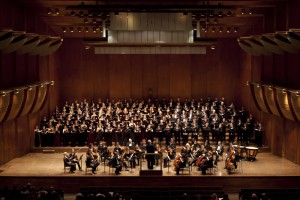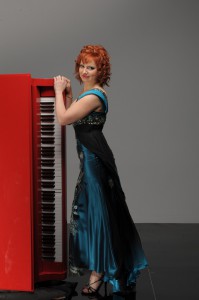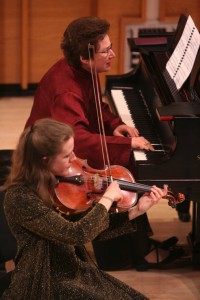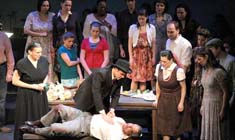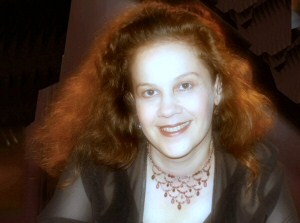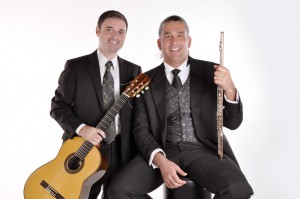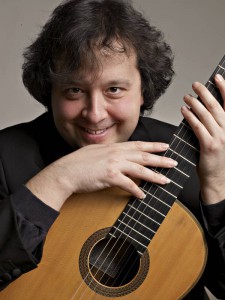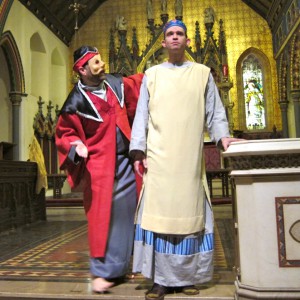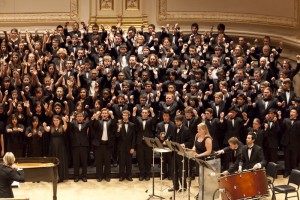
This Shining Night: The Music of Lauridsen and Whitacre. Photo Credit: DCINY Production/Richard Termine
Eric Whitacre conducted amazingly well-prepared choruses in presentations of his music, which ranged from 1992 to the present, and he also conducted two lovely renditions of works by Morten Lauridsen. The singers, mostly students from high school and university choruses throughout the United States, all sang from memory with excellent pitch, diction, balance, phrasing and rhythm, plus complete devotion to each work. The music contrasted from the sublime (most of the works had to do with the night, sleep or dreams) to the ridiculous (Ogden Nash’s texts in “Animal Crackers”), and the full-house at Carnegie Hall seemed captivated by every selection.
The evening began with “Lux Aurumque”, a serene and poignant work with fascinating harmonies. But even more touching and unsettling was the setting to Octavio Paz’s text to “A Boy and a Girl”. By contrast, “Animal Crackers”– in two short volumes–riotously showcased boys singing high falsetto in “The Cow”, and cleverly incorporated familiar strands such as the opening chords of Tchaikovsky’s B-flat Piano Concerto and “Oh Tenenbaum” in the song “The Kangaroo”. Just as catchy was “The Canary”, humorously set to repetitious music on the words “..never varies”. The excellent pianist for the evening was Tali Tadmor. Ogden Nash’s texts are indeed hysterical, but Whitacre’s music added even more to the hilarity. The audience had a blast.
“Five Hebrew Love Songs”, with a fine string quartet at hand, provided a welcome variety within its five settings. It was idiomatic and ethnically authentic, complete with precise tambourine in its dance movement. There was some ragged ensemble (in the male voices) only once in a tricky section. The work entitled “the city and the sea” contained more dense harmonies and even more fascinating counterpoint; the “Little Man in a Hurry” movement was the highlight, with its catchy melisma and mixed meters.“Cloudburst” was as evocative and mystical as “the city and the sea” was invigorating and exuberant. It goes ‘Old World’, with chants in 5ths, but then intersperses modern techniques such as aleatoric writing and minor-second clusters. The sustained voices over the counterpoint sounded sublime. The celestial swells were reminiscent of Ravel’s “Daphnis et Chloe”, and the rattling percussion, plus clapping and snapping sounds provided with unity and confidence by the chorus added to the sensations and imagination.
“Go, Lovely Rose”, Whitacre’s first composition from 1992, contained impressive high solos for tenor and soprano, and they were performed admirably. Harmonically, the piece is more daring than you would think from such an early composition (he was only 21 at the time). “Sleep”, was evocative, atmospheric and beautifully performed by the large chorus; the cloudy harmonies and mysterious atmosphere are reminiscent of “Sirenes” from Debussy’s “Nocturnes” or music from “Neptune” in Holst’s “The Planets”–both for women’s voices and usually sung off stage. Whitacre’s music, even though seemingly inspired by strokes of genius in the late 19th and early 20th centuries, still has much to offer–especially to young people. The concluding, extremely gradual ‘fade-out’ was astounding for its breath control and dynamic color; it disappeared into the night.
Morten Lauridsen’s “Sure on This Shining Night” and “Dirait-on”, based on the text by Ranier Maria Rilke from “Les Roses”, made fitting partners to Whitacre’s “Sleep” music, but instead of being ethereal-sounding like the Whitacre work, Lauridsen’s night music–while sharing similar ideologies–was less mysterious and chromatic and sounded more harmonically open, earthy and lush (an appropriate musical style for settings to poetry like “Les Roses”). Mr. Lauridsen performed at the piano while Mr. Whitacre conducted. Lauridsen’s consistently tender music provided an endearing close to this very impressive program.
The excellent choruses that participated in this successful Carnegie Hall concert were the Desoto Central High School Chorale (MS), Legacy Christian Academy Concert Choir (TX), Orrville High School Choir (OH), West Monroe High School Choir (LA), Winter Springs High School Chorus (FL), Classical Ensemble and Bel Canto Choirs (CA), Delta State University Chorale (MS), The Lowell Choir (CA), molto cantabile (Switzerland), Olive Branch High School Choir (MS), Ridgeland High School Choir (MS), River Dell High School Select Choir (NJ), and the Rose Choir (NJ). They could not have been better prepared by their directors.

